Change Page: 1234567 > | Showing page 1 of 7, messages 1 to 20 of 131 - powered by ASPPlayground.NET Forum Trial Version
Author
|
Message

|
 Incubating Centropyge eggs and prolarvae.
Tuesday, April 19, 2011 1:24 PM
Incubating Centropyge eggs and prolarvae.
Tuesday, April 19, 2011 1:24 PM
( permalink)
Of all the marine ornamental fish possible to breed in captivity (meaning that they could be done some time),arguably Centropyge pigmy angels are the most difficult and challenging.This despite tremendous efforts by seasoned experienced breeders and well staffed and funded commercial and academic facilities.And this is not just a matter of finding the right larval food,there are previous aspects that must be adressed before we start the actual larval raising game,which are: 1-obtaining large numbers of healthy developing eggs.This was treated in: http://www.mbisite.org/Forums/tm.aspx?m=51596 2-incubating them until they become feeding larvae. 3-raising the larvae. 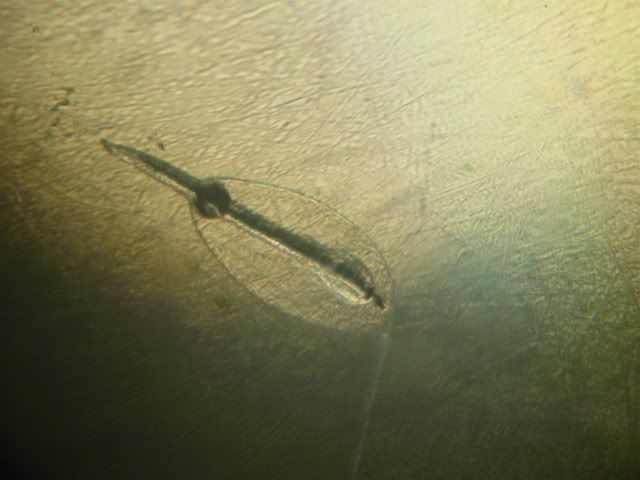 I will now deal with the second point.One could think that there is no need for this step,and that the eggs could be merely dumped in the larval tank,as happens with some food fish rearing.But seemingly these eggs and prolarvae need to be kept floating in undisturbed conditions. So I am incubating the early stages in 2L white trays.I first put a black plastic sheet at the bottom,since the eggs are invisible against a light background,but then found that the hatched prolarvae show early pigmentation and are easy to see.They look very much like a well fed adult Artemia (though tiny),with the head bent downwards,and the oil globule seeming like the Artemia egg sacs. This is a prolarva caught in the moment of hatching,see the broken "shell" (chorion) and the embryo pulling out of it: 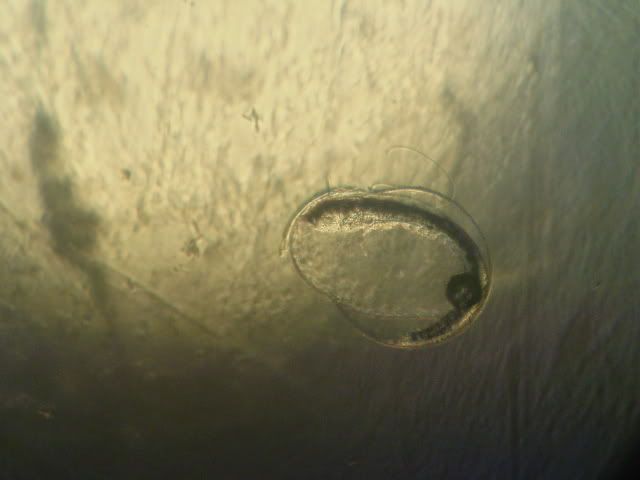 And this is how a free prolarva looks,under a scope,you don´t see the yolk sac in direct view: 
|
|
|
 Re:Incubating Centropyge eggs and prolarvae.
Tuesday, April 19, 2011 1:35 PM
Re:Incubating Centropyge eggs and prolarvae.
Tuesday, April 19, 2011 1:35 PM
( permalink)
This is going to be an interesting discussion. Thanks for sharing the info. 
|
|
|
 Re:Incubating Centropyge eggs and prolarvae.
Tuesday, April 19, 2011 4:28 PM
Re:Incubating Centropyge eggs and prolarvae.
Tuesday, April 19, 2011 4:28 PM
( permalink)
Amaizing Luis, I am looking forward to your observatios and progress over the coming months.
|
|
|
 Re:Incubating Centropyge eggs and prolarvae.
Tuesday, April 19, 2011 5:32 PM
Re:Incubating Centropyge eggs and prolarvae.
Tuesday, April 19, 2011 5:32 PM
( permalink)
I find that early prolarvae of the wrasse I'm working with are really sensitive to deteriorating environmental conditions. Given that they need to be in still water, this is a large challenge indeed. The suggestion from the recent yellow tang discussion was to keep them in small downwellers (to keep the prolarvae concentrated) in large tubs of water (to keep environmental conditions stable). I also find that pelagic eggs are very susceptible to bacterial issues. Dipping the eggs into a hydrogen peroxide solution before going into a hatching container seems to help.
--Andy, the bucket man. "Not to know the mandolin is to argue oneself unknown...." --Clara Lanza, 1886
|
|
|
 Re:Incubating Centropyge eggs and prolarvae.
Tuesday, April 19, 2011 5:44 PM
Re:Incubating Centropyge eggs and prolarvae.
Tuesday, April 19, 2011 5:44 PM
( permalink)
Andy,yours are 6 lined,right?.I was also concerned about WQ issues in standing water... Oops I duplicated a pic but couldn´t edit later  Some more,this shows the yolk sac larger than the body: 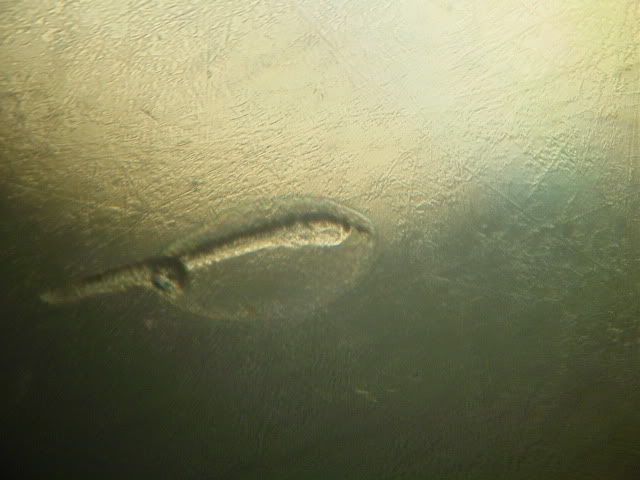 And a full profile,showing the black pigmentation: 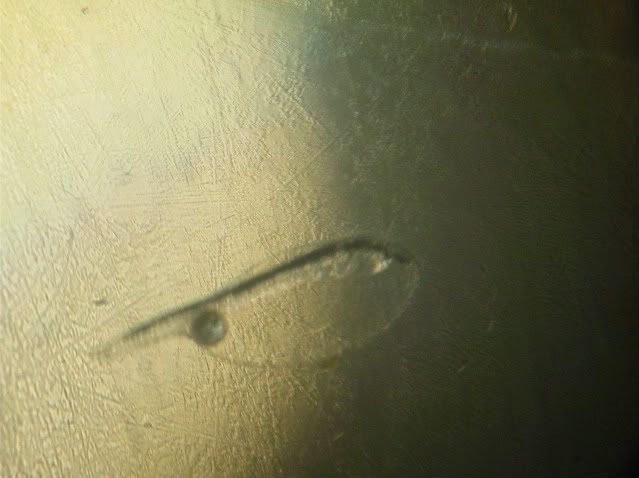 Lastly a hatching egg,close to a prolarva: 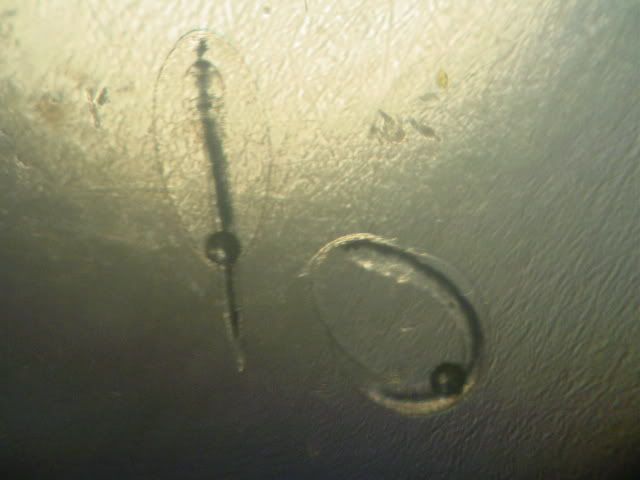
|
|
|
 Re:Incubating Centropyge eggs and prolarvae.
Tuesday, April 19, 2011 5:50 PM
Re:Incubating Centropyge eggs and prolarvae.
Tuesday, April 19, 2011 5:50 PM
( permalink)
I am also a great fan of H2O2. I think its under utilised as it can be very caustic. I also use it to remove parasites off new fish prior to placing in my brrodstock system. I use 1ml per litre at 12% concentration and I bathe fish for 30min to an hour.
|
|
|
 Re:Incubating Centropyge eggs and prolarvae.
Tuesday, April 19, 2011 8:21 PM
Re:Incubating Centropyge eggs and prolarvae.
Tuesday, April 19, 2011 8:21 PM
( permalink)
How does H2O2 compares to formalin?
|
|
|
 Re:Incubating Centropyge eggs and prolarvae.
Wednesday, April 20, 2011 2:21 AM
Re:Incubating Centropyge eggs and prolarvae.
Wednesday, April 20, 2011 2:21 AM
( permalink)
I've never used formalin so can't compare.
|
|
|
 Re:Incubating Centropyge eggs and prolarvae.
Wednesday, April 20, 2011 7:16 AM
Re:Incubating Centropyge eggs and prolarvae.
Wednesday, April 20, 2011 7:16 AM
( permalink)
--Andy, the bucket man. "Not to know the mandolin is to argue oneself unknown...." --Clara Lanza, 1886
|
|
|
 Re:Incubating Centropyge eggs and prolarvae.
Wednesday, April 20, 2011 11:19 AM
Re:Incubating Centropyge eggs and prolarvae.
Wednesday, April 20, 2011 11:19 AM
( permalink)
Do the prolarvae make any effort to swim or orient themselves or do they just lie there? Do you hold the prolarvae with any light and if so do you have it on a photoperiod? I've hatched a few Halichoeres eggs, mine just kind of lie around unless flow moves them. Prolarvae are really hard for me to see. I got a reusable all plastic coffee filter and set that in new saltwater, with aeration under the filter not in it. The eggs are peroxide dipped and every piece of gear is sterilized beforehand or they do not last. The prolarvae are held in the filter(s) and thus kept within the 2" I can see. That's as far as I got with the experiment before I flooded my basement, need to start again soon as the H chrysus are really going for it these days. Also need to alter my overflow, a lot of eggs get damaged with my current setup. I know it's kind of pointless anyways, but I still play with the eggs. Thanks for posting this. Kate
|
|
|
 Re:Incubating Centropyge eggs and prolarvae.
Wednesday, April 20, 2011 1:02 PM
Re:Incubating Centropyge eggs and prolarvae.
Wednesday, April 20, 2011 1:02 PM
( permalink)
 Originally Posted by Umm_fish? Amazing,Andy.Time to progress with the work! See that the oil globule is placed in the front end,while it is in the rear of Centropyge prolarvae.
|
|
|
 Re:Incubating Centropyge eggs and prolarvae.
Wednesday, April 20, 2011 1:09 PM
Re:Incubating Centropyge eggs and prolarvae.
Wednesday, April 20, 2011 1:09 PM
( permalink)
Kate,they just float around,wiggling ocassionally.Ambient light,14hrs L.But prolarvae don´t have working eyes,so I don´t thing this could matter. Pelagic spawners are our last frontier,if we work as a team,we can make it!
|
|
|
 Re:Incubating Centropyge eggs and prolarvae.
Thursday, April 21, 2011 7:03 PM
Re:Incubating Centropyge eggs and prolarvae.
Thursday, April 21, 2011 7:03 PM
( permalink)
2nd day.They are now on the bottom,standing head down.And most are concentrated in the corner of the tray closest to a window.So Kate,now they can see the light and orient towards it. Pics of the 2nd day AM:  Prolarvae are 2mm TL and the yolk sac is reduced.This is better seen in a lateral view.Eyes are developing,and the cloaca can be seen. 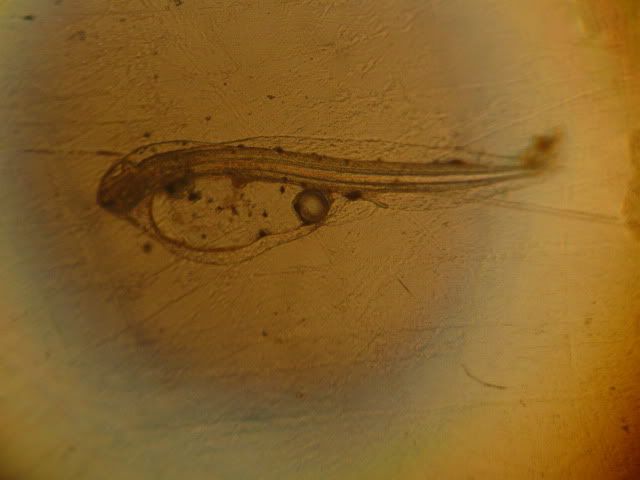
|
|
|
 Re:Incubating Centropyge eggs and prolarvae.
Thursday, April 21, 2011 7:09 PM
Re:Incubating Centropyge eggs and prolarvae.
Thursday, April 21, 2011 7:09 PM
( permalink)
Nice shots. Do you think the fact that they are concentrating in one area because of the light will affect their health and development?
|
|
|
 Re:Incubating Centropyge eggs and prolarvae.
Thursday, April 21, 2011 7:18 PM
Re:Incubating Centropyge eggs and prolarvae.
Thursday, April 21, 2011 7:18 PM
( permalink)
 Originally Posted by Duck
Nice shots.
Do you think the fact that they are concentrating in one area because of the light will affect their health and development?
Not at all,they are not so many,they are loosely "concentrated".Meaning that most of them are found around that corner.Many larvae are phototactic,move towards the light.Prolarvae exhibit this behaviour on day 2,showing that their eyes can now register the light.
|
|
|
 Re:Incubating Centropyge eggs and prolarvae.
Thursday, April 21, 2011 10:16 PM
Re:Incubating Centropyge eggs and prolarvae.
Thursday, April 21, 2011 10:16 PM
( permalink)
very nice Luis i havent begin with pelagic ones but you always inspire me to try somethig more so maybe soon......
|
|
|
 Re:Incubating Centropyge eggs and prolarvae.
Friday, April 22, 2011 9:05 PM
Re:Incubating Centropyge eggs and prolarvae.
Friday, April 22, 2011 9:05 PM
( permalink)
 Originally Posted by efren villegas
very nice Luis i havent begin with pelagic ones but you always inspire me to try somethig more so maybe soon......
Gracias,Efren!  .Most pelagic spawners are families of large fish.Among the ones small enough for typical hobbyist´s tanks,we have the mandarins,the small angels and many nice labrids (wrasses). On day 3 AM,I could see only two prolarvae.Water is full of ciliates,which means lots of bacteria=organic load=polution.   The yolk sac is almost completely reabsorved,and the oil vacuole has moved forward.The gut is completely formed but the mouth is undeveloped,and eyes are not fully pigmented.No cardiac activity could be seen,and the prolarva moves only occasionally.TL is now 2.4 mm.
|
|
|
 Re:Incubating Centropyge eggs and prolarvae.
Friday, April 22, 2011 9:10 PM
Re:Incubating Centropyge eggs and prolarvae.
Friday, April 22, 2011 9:10 PM
( permalink)
Sorry to hear about the ciliates. Very cool pix though! It's hard to believe that such tiny/fragile organisms survive in the wild and become adults.
|
|
|
 Re:Incubating Centropyge eggs and prolarvae.
Saturday, April 23, 2011 10:58 AM
Re:Incubating Centropyge eggs and prolarvae.
Saturday, April 23, 2011 10:58 AM
( permalink)
Great shots Luis! Nice to see how you are progressing! Do you have any pictures of your spawning set up? Thanks much.
|
|
|
 Re:Incubating Centropyge eggs and prolarvae.
Saturday, April 23, 2011 12:27 PM
Re:Incubating Centropyge eggs and prolarvae.
Saturday, April 23, 2011 12:27 PM
( permalink)
Thanks I had wondered. I was using a little .5 watt LED light over the "incubator". After breaking it down I used the LED light to spotlight a chalice, which burned a hole in it, so apparently it is not an appropriate light. Then I read Wittenrich's book which suggested damage from bright lights. So I had wondered what the angelfish breeders were doing. The incubator was a small sump with shelves in it intended for bioballs and/or filter pads. Also has a float valve. The shelves hold a bowl or coffee filter in a bath for the eggs, and I can put a powerhead and heater below the shelf. It has lids. So I can keep the eggs in a dish and have high enough ambient humidity to keep evaporation at a minimum, or if I know there are no pods in the sump I can put the coffee filter on the shelf minus the bowl. Works pretty well. I aerate below the eggs, and hatch rate is miserable if I don't peroxide the gear and eggs first. I have only hatched a few and they were pretty listless so was not sure if they were viable. I don't expect to raise them, set my goals really low. IE what foods do the parents need, what triggers spawning, how to get the eggs, how to incubate. It seems like they take longer than 24 hours to hatch. I know all the literature states it's 24 hours. Makes me wonder about my techniques. Your photos are great! Thanks, Kate
 Originally Posted by luis a m
Kate,they just float around,wiggling ocassionally.Ambient light,14hrs L.But prolarvae don´t have working eyes,so I don´t thing this could matter.
Pelagic spawners are our last frontier,if we work as a team,we can make it!
|
|
|
|